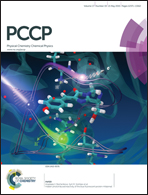A new diluted magnetic semiconductor based on the expanded phase of ZnS: surmounting the random distribution of magnetic impurities†
Abstract
Because of the strong d–d interactions, the doped transition metal (TM) atoms in the semiconducting host matrix tend to cluster and form a random distribution or a chemical phase separation. Hence it is a long-standing dream to achieve the desired diluted magnetic semiconductor (DMS) with regularly and separately distributed TM impurities and room-temperature ferromagnetism. Here we, for the first time, demonstrate via accurate ab initio calculations that the cage-like building block Zn12S12 of the novel cluster-assembled sodalite phase of ZnS can provide an appropriate potential well to trap a foreign Mn atom, realizing regular distribution of the doped magnetic atoms. Interestingly, the endohedrally doped Mn@SOD–ZnS displays a ferromagnetic (FM) ground state with the encapsulated Mn atoms preserving their highly atom-like magnetic moment. Furthermore, such a framework is predicted to possess room-temperature half-metallicity. A detailed analysis of the electronic structure shows that the FM half-metallicity originates from the competition between the FM double exchange interaction and the anti-ferromagnetic (AFM) super-exchange interaction. The present study highlights a new avenue to achieve the needed DMS with regular distribution of the magnetic impurities.


 Please wait while we load your content...
Please wait while we load your content...